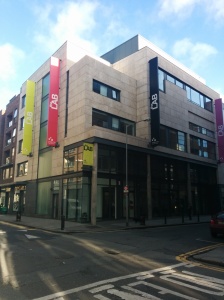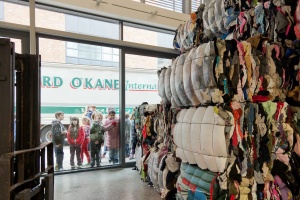(Interview with Sheena Barrett, arts officer and curator @ The LAB)
The LAB is Dublin City Council’s Arts Office, a dynamic hub of activity housing a gallery, rehearsal and incubation space for a range of art forms. It’s on Foley Street just off Talbot Street. It’s very near Busaras and Connolly Station, in the heart of a really historic part of the city once known as ‘the Monto’, a cultural pocket with neighbours including Oonagh Young Gallery, Dance House, Talbot Gallery & Studios and creative pop up spaces Units 3 & 4.
What happens there?
The Arts Office is based here and we run a range of programmes, provide advice, funding and support to artists and communities across the city. The building itself is full of flexible spaces that take on different energies depending on who is in them. Last week we had an international symposium on performance with speakers from New York and Sweden occasionally interrupted by singing children at their contemporary dance class in the room next door. Meanwhile, downstairs, we had some actors doing a read through next door to opera rehearsals. There’s also an MA from iadt for artists, curators and critics. So while the gallery is showing work that’s at a stage ready to invite in the public, artists across all art forms are busy honing their craft upstairs.
In the LAB Gallery, we support emerging artists, often providing them with their first solo show. We also focus on fresh ways to develop engaged audiences for the visual arts; we have a programme of events, talks and workshops with every show.
What is your role and how did you get there?
I’m an arts officer and curator with Dublin City Council. I studied History of Art and French and subsequently Arts Administration & Culture Policy at UCD. I previously worked as Project Manager for Breaking Ground, Ballymun Regeneration’s art commissioning programme. I have also worked at the National Museum of Ireland and the National Gallery of Ireland, Temple Bar Gallery & Studios, Artworking Consulting and at the Peggy Guggenheim Collection, Venice. I joined Dublin City Council’s Arts Office 8 years ago just after the LAB was built. At the LAB I curate the gallery’s exhibition and events programme.
(Image – looking for rainbows – visit from local montessori group to our last exhibition)
What makes The LAB special?
What makes the LAB special is our relationship with artists and audiences. We work really hard to support artists through the process of making work but we don’t think it stops once the show opens. We want to get people talking about art, but also about the issue the art raises. We actively encourage artists to work with people from other disciplines, like architects or engineers – or nine-year-olds. We love when artists are interested in the world around them and we can introduce to them to other interesting people and they have those moments of understanding, or share ideas and knowledge.
(Image of artist Aisling O’Beirne meeting Professor Luke Drury at Dunsink Observatory to prepare for her forthcoming show in September)
There have been lots of highs. A recent one was For The Birds a one-off event created by James Ó hAodha for Tonight, You Can Call Me Trish, curated by two young curators who won our emerging curator award, RGKSKSRG. As part of the exhibition, James was commissioned to devise an encounter with a specific community of interest. His work For the Birds consisted of a series of idiosyncratic exhibition tours, which took place in the gallery on the final day of Trish. It was pretty special.http://vimeo.com/91276197
I also love quieter moments, like people’s responses to our current solo exhibition Ultra, by Barbara Knezevic and I really enjoyed the talk she gave on the opening night. I find artistic processes very interesting, and I sometimes find those conversations become even more interesting when they are discussed with others, like when Geraldine O’Reilly will be talking to poet John F. Deane (DWF: Wed 21st May @6pm). It allows for the unexpected, and the audiences tend to be very involved in sharing their own interests and responses.
Can you talk about The LAB’s setting, and how it interacts with its neighbours?
The LAB is on Foley Street. It’s a really urban space, surrounded by new office and apartment blocks. It’s also a really historic part of the city with families who’ve lived here for generations who remember when this street had tenements, sewing factories and the infamous Monto. It is an area deeply imbedded in the history of the Lockout in 1913, the Easter Rising and the War of Independence.
(images courtesy Terry Fagan, North Inner City Folklore Project Foley Street in the 70s)
I think the historic nature of the place can really add great potency to politically charged exhibitions. You really feel the weight of history.
A few years ago we had an exhibition of live performance curated by Amanda Coogan called Labour showing work by ten Irish female performance artists. It was a very intense experience to be involved in and I think has to be one of my highlights. The work had toured from London and Derry but in a sense the issues raised seemed so at home in this context. It was very poignant.
What makes you cranky?
Lot of things! Mostly what I listen to on the radio in the mornings. I think there are so many incredibly interesting people in this country and we don’t hear their stories enough. What I love about this work is the moments when people come together and experience really great projects, where artists took huge risks, might have failed, but still did it and put themselves out there. What makes me cranky is not being able to support more of it, take more chances, and find ways to shout about it a bit louder so more people can choose to get involved.
If The LAB wasn’t here what might be here in it’s place?
I wonder about that. Sometimes I wonder if one of the best things for the people who walk down this street is that it feels a bit safer, or there’s something curious to look at. It has always been an issue for me that the office blocks across the street keep their shutters down, even though people are working inside. Surely the streetscape deserves better. I think there’d still be a need a for place like this, but I love that it’s here. We’re just off the bustling thoroughfare of Talbot Street, tucked away in a place that’s quiet enough to look at the work, but alive enough to make you question how it fits in with the rest of our lives. That’s pretty special.
(image – installing Catherine Delaney exhibition, other-stuff, 2012)
Admission to The LAB Gallery is free Monday to Friday 10am to 6pm and Saturdays 10am to 5pm
The Lab, 1 Foley Street, Dublin 1














